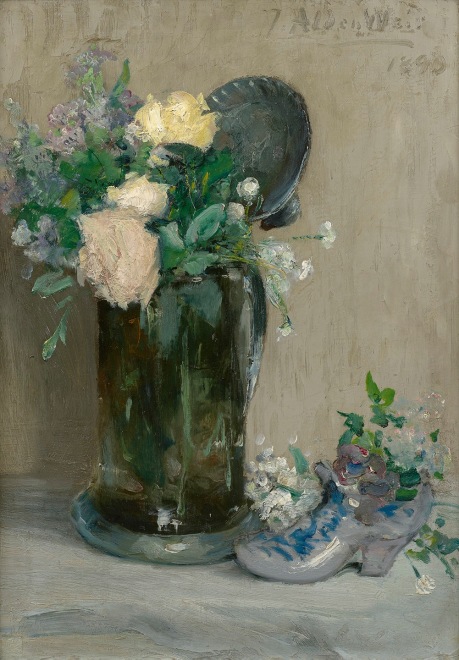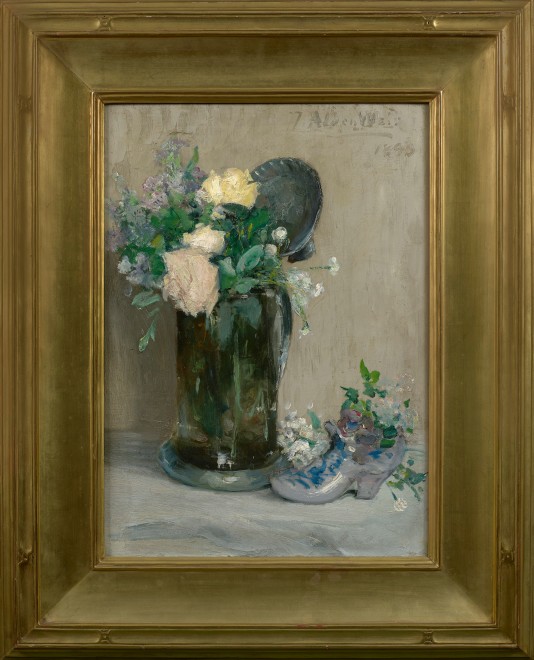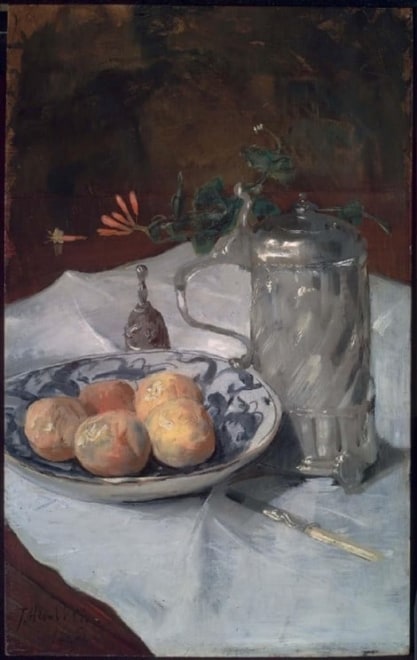Provenance
The artist
Thence by descent, Mrs. George Page Ely (born Caroline Weir), his daughter, 1919
Thence by descent, Caroline Page Ely, her daughter, 1973
Adelson Galleries, New York, 1994 (acquired from the above)
Private collection, California, 1994 (acquired from the above)
Exhibited
New York, Metropolitan Museum of Art, October 13, 1983 – January 8, 1984; Los Angeles, The Los Angeles County Museum of Art, February 9 – May 6, 1984; Denver, The Denver Art Museum, June 13 – August 19, 1984, J. Alden Weir: An American Impressionist, no. 3.65, pp. 142, 302, ill.
New London, Connecticut, Lyman Allyn Art Museum, J. Alden Weir, December 1989 – January 1990 (as The Wooden Shoe)
New York, Adelson Galleries, American Impressionism: Boston, New York, Paris, November 15 – December 17, 1994, np., no. 36, ill.
Catalogue note
Julian Alden Weir and Anna Dwight Baker had only known each other a little over a year when they were married on April 24, 1883.[i] Anna, who first saw Weir when she accompanied a friend to a class he was teaching, returned for two additional sessions, despite the fact that her interest was theater. The two also had a connection with the West Point Military Academy; Weir’s father Robert was an esteemed professor of drawing at the Academy for forty-two years (1832–1876) and Anna’s father served as instructor of tactics there from 1845 to 1851. Julian Alden Weir was born at West Point in 1852.
Nonetheless, their backgrounds were different. Anna came from a privileged and affluent family. Her parents, both of Puritan ancestry, were wealthy and traveled to Europe frequently with their children. Weir had been raised in a more humble environment, yet one richly steeped in culture. He was educated by his father and studied the enormous collection of prints and books that Robert had acquired in Italy in the late 1820s. His father introduced him to leading figures in the Hudson River School, including Thomas Cole, Asher B. Durand, and Frederic Church.
His half-brother, John Ferguson Weir, also expanded his artistic horizons. When John traveled to Europe from 1868 to 1872, he let his younger sibling stay in his studio in New York’s Tenth Street Studio Building, home to many of the leading artists of the day. J.A. Weir enhanced his own worldliness in European study and travel. From 1873 through 1877, he lived in Paris, where he was a favorite student of Jean Léon Gérôme at the École des Beaux-Arts. He also received instruction privately from Gustave Boulanger and attended the Gratuite de Dessin (the Petite Ecole), where he drew from life and the Antique and studied sculpture with Amédee Faure and Aimé Millet. In the summers, he painted in Brittany and traveled to Holland, Belgium, Spain, and London, where he visited James McNeill Whistler.
Given the differences in their upbringing, Weir feared that that he could not give Anna the “comforts and luxuries” to which she was accustomed, and he wished he had been able to be successful before asking her to marry him.[ii] However, to Anna, this was of little importance. The couple had a long honeymoon in Europe. Between April and September 1883, they visited Paris, Stuttgart, Nuremberg, Munich, Tyrol, Venice, Dordrecht, and The Hague. On a trip to London, Weir acted on behalf of the banker and philanthropist Henry Gurdon Marquand, purchasing paintings for the latter’s collection, including a work by Rembrandt.[iii]
From Paris, Weir wrote to his brother John, expressing his feeling that as a married man, it was time for him to return home, where the “main stay” of his life might be “found better.” He planned to “hammer at portraits” to make a living.[iv] Accordingly, the Weirs returned to America in September of 1883, settling into a tiny New York apartment at 31 West 10th Street. On March 24, 1884, they welcomed their first child, Caroline Alden Weir (1884 – 1973), whom they called Caro.
Although Weir had expected to support himself from portraiture on returning from his honeymoon, the growing popularity of photography made it difficult for him to obtain portrait commissions, and he therefore relied on the salary he received from teaching art classes at Cooper Union and the Art Students League. After selling his large allegorical canvas, The Muse of Music (1881–1884, private collection, St. Louis) in 1884, the family spent the summer in the farmhouse in Branchville, Connecticut, that Weir had purchased in 1882. At the end of the year, they returned to the City, where Weir focused his efforts on painting those close to him, particularly Anna and Caro.[v] These paintings, often large-scale works, show the progression from Weir’s earlier Academic approach to a more progressive painting style.[vi]
From the 1880s until the early 1890s, in addition to painting his wife and daughters (Caro, Dorothy, born in 1890, and Cora, born in 1893), Weir established a reputation as a still life painter. As a student in Paris, his still life works were mostly kitchen objects, but by 1884, he was painting flowers and other decorative objects.[vii] In the current example, the artist used his preferred vertical format but, unlike earlier still life paintings, it is executed in a lighter, brighter palette with heavy impasto. The silver tankard and ceramic shoe reflect the light, flower blossoms, and greenery against a neutral background. The smooth surfaces indicate the artist’s use of a palette knife to apply thick layers of paint, a technique he also used in The Delft Plate, 1888 (Museum of Fine Arts, Boston). Weir’s more casual still life paintings from this period were inspired by a resurging interest in the still lifes of Jean-Baptiste-Simeon Chardin (1699 – 1779) in France during the 1850s – 1860s, which influenced the still lifes of Edouard Manet as well as American painters William Merritt Chase and Soren Emil Carlsen.[viii]
In the early 1890s, Weir began to adopt fully an Impressionist painting style, which suited his growing interest in depicting landscapes. He was soon considered a leading member of the new Impressionist group of painters emerging in America at that time. In 1898, he became one of the founding members of The Ten, which was a group including Childe Hassam, Willard Metcalf and John Henry Twachtman, among others. His homes at Branchville and Windham provided endless inspiration for his lyrical landscapes made up of loose brushwork and pale colors, often shades of blue, yellow, and green.
[i] The main sources on Weir are Dorothy Weir Young, The Life and Letters of J. Alden Weir (New Haven: Yale University Press, 1960); Doreen Bolger Burke, J. Alden Weir: An American Impressionist (Newark: University of Delaware Press, 1983); Hildegard Cummings, Helen K. Fusscas, and Susan G. Larkin, J. Alden Weir: A Place of His Own (Storrs, Connecticut: William Benton Museum of Art, the University of Connecticut, 1991); and Nicolai Cikovsky, Jr., et al, A Connecticut Place: Weir Farm—An American Painter’s Rural Retreat (Wilton, Connecticut: The Weir Farm Trust, 2000).
[ii] Young, p. 153.
[iii] Henry Gurdon Marquad (1819 – 1902) was a New York financier. He made his fortune as the Director of the Equitable Life Insurance Company and his financial interest in several railroads. In 1880, he retired from the business world and concentrated on art acquisition. He was also a founding member of the Metropolitan Museum of Art, served as President of the Museum’s Board of Trustees and a member of the building committee and donated to the collection. https://en.wikipedia.org/wiki/Henry_Gurdon_Marquand. Accessed February 3, 2021.
[iv] Young, p. 162.
[v] These works include (oils unless otherwise indicated): Anna on the Balcony of Duveneck’s Studio (1883, Brigham Young University Museum of Art, Provo, Utah); Against the Window (1884, private collection); Anna Sewing (1885, watercolor, private collection); Anna Seated (1885, pencil and watercolor, private collection); A Reverie (1886, private collection); Anna and Caro in the Twelfth Street House (1887, pencil, watercolor, and gouache, private collection); The Miniature (1888, Heckscher Art Museum, Huntington, New York); Idle Hours (1888, Metropolitan Museum of Art); In the Library (late 1880s, pencil, watercolor, and gouache, private collection); and The Letter (1890, pencil, watercolor, and gouache, private collection).
[vi] Burke, p. 111
[vii] Ibid., pp. 126 - 127
[viii] Ibid., pp. 138 - 141






